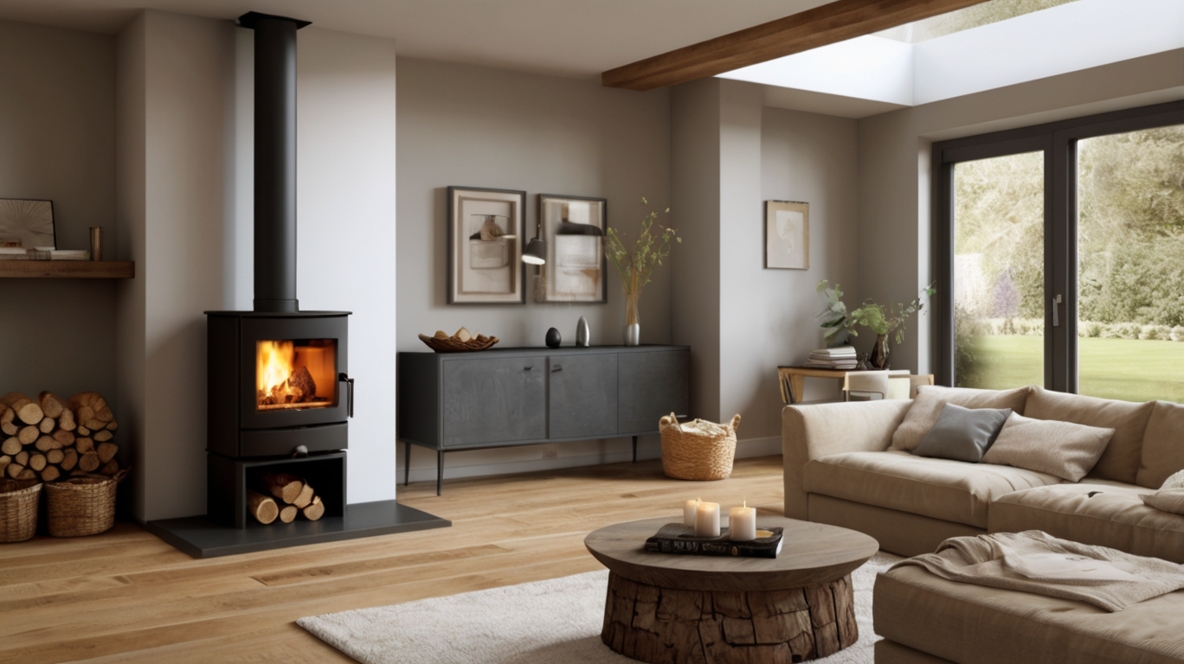Wood burning stoves have a strange way of making a living room feel alive. It’s like their crackles tell small stories to anyone who’ll listen. The warmth they throw out doesn’t just heat walls, it creeps into your bones, quietly, without asking permission. In 2025, wood stoves aren’t just old-school relics tucked in dusty corners they’re design stars, center stage, glowing with personality.
Designers have stopped treating them as an afterthought. Instead, they’re anchoring entire spaces around them. And honestly, that’s the best decision some homes ever made. Below, I’ve pulled together 20 ideas that twist tradition a little, add fresh flavor, and honestly might make you want to rearrange your furniture tonight.
1. Rustic Core with a Modern Wrap
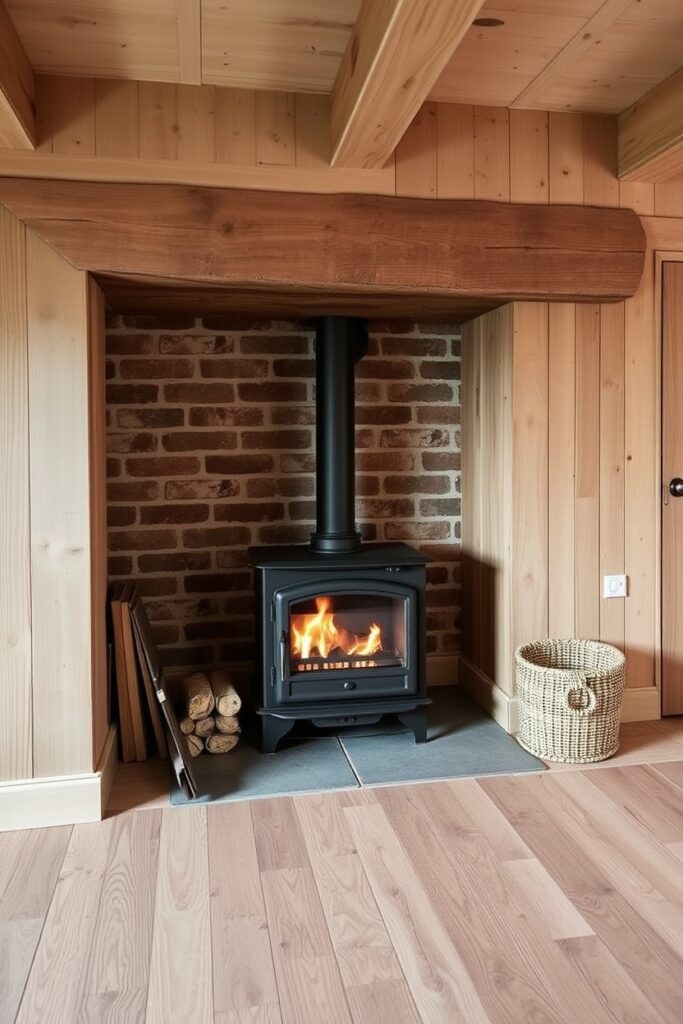
Picture a squat black cast-iron stove, but instead of sitting in a plain brick nook, it’s wrapped by pale timber walls that look like they’ve been freshly sanded. A contrast like this hits you sideways. The raw warmth of the wood softens the solid, no-nonsense stove like a lumberjack wearing a silk scarf.
In 2025, rustic doesn’t mean dusty anymore. Think wide-plank oak floors, matte finishes, clean edges. The stove becomes a centre piece rather than just a heat source. It sits proudly, with space around it to breathe, like a sculpture in a quiet gallery.
If you’ve got exposed beams overhead, even better. Let them stay slightly imperfect. A nick here, a groove there they give character, and when the fire’s on, those imperfections dance in the flickering light.
2. Suspended Elegance in Open-Plan Spaces
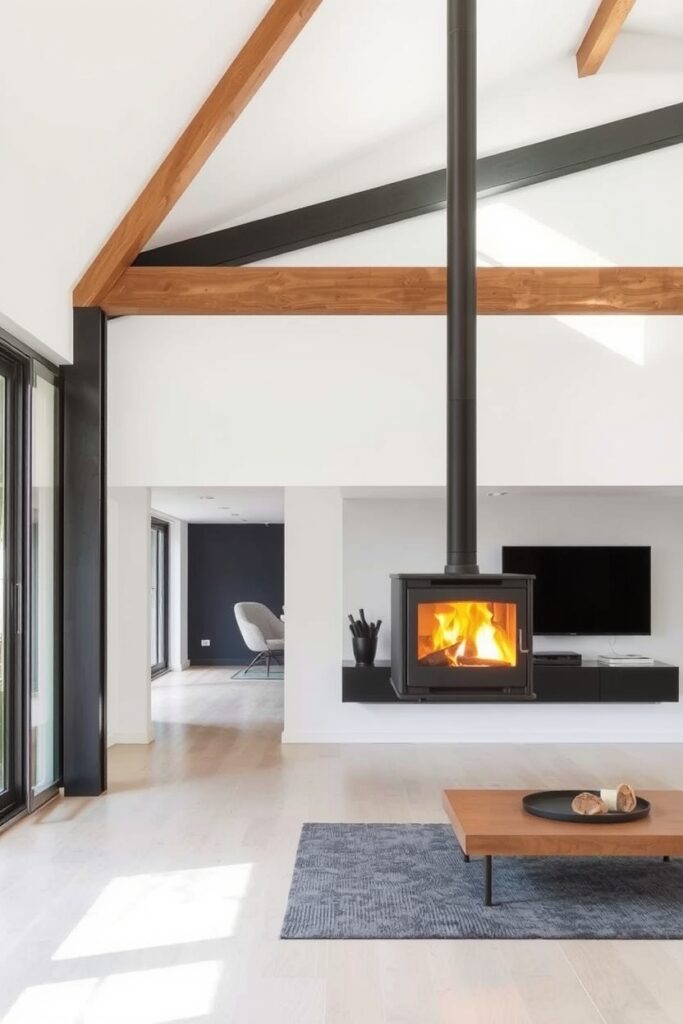
This one’s for the brave hearts. A suspended wood-burning stove hanging slightly above the floor in the middle of a big open living area. Sounds mad? It works. It’s sculptural, unexpected, and very 2025.
Imagine walking into a room and seeing a stove hovering, pipe stretching up to the ceiling like a slim chimneyed tree. No chunky walls, no heavy surrounds. Just clean lines and warm radiance reaching out in every direction.
This idea is perfect for modern loft apartments or homes with vaulted ceilings. The stove acts like a glowing anchor in a sea of openness, pulling the space together without any fuss. You almost expect it to start floating upwards like a hot-air balloon.
3. Sunken Lounge with a Stove at Eye Level
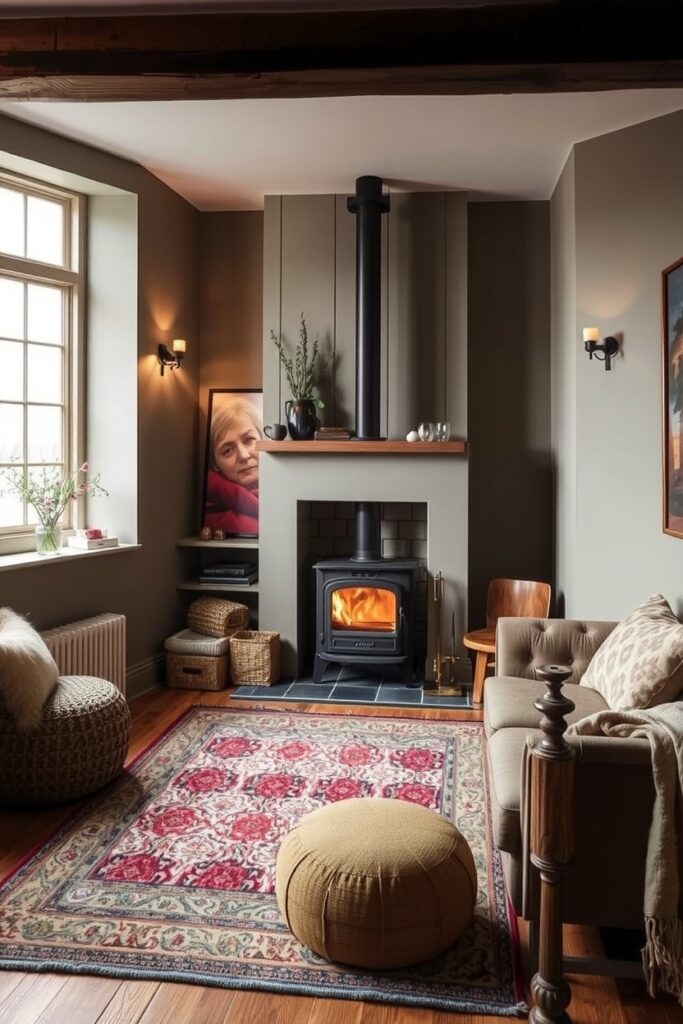
A sunken living area is cheeky. It dips below the rest of the house like a quiet pocket, a place where conversations stretch longer and laughter echoes differently. Drop a wood-burning stove at eye level in the sunken zone, and the effect is magical.
When you sit down, you’re staring directly into the flames, not looking down on them. It changes the dynamic completely. It feels more intimate, more conspiratorial, like the fire’s part of the group chat.
Pair the stove with thick, layered rugs, slightly low seating, and wall sconces that give off soft pools of light. The space feels wrapped up in itself, protected. Perfect for stormy evenings when the wind keeps tapping at the windows.
4. Industrial Chic Meets Cabin Comfort
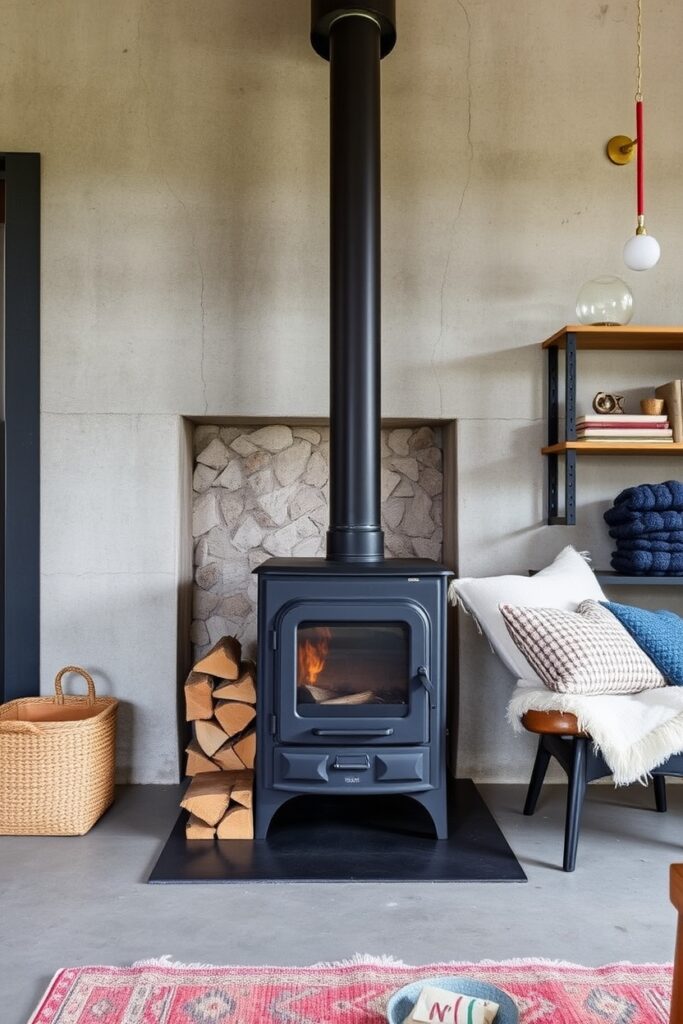
Industrial and cozy sound like enemies, but when you get them in the same room, they can do wonders. A raw concrete wall, maybe a little cracked, serves as the backdrop. A steel wood stove sits upfront, simple and clean. Add a stack of chopped logs tucked into a cubby, and suddenly the rough edges feel deliberate.
The trick is balance. Metal furniture frames, open shelving, slightly oversized lighting fixtures these give it that factory feel. Then layer it with wool throws, chunky knits, and one too many cushions. It’s like wearing boots with a soft hoodie. Unexpected but strangely right.
In 2025, industrial interiors are softening. No one wants cold anymore. People crave tactile surfaces, little imperfections, textures that feel like they’ve lived a bit. That’s where a wood-burning stove slides in effortlessly.
5. Scandinavian Calm with Pale Tones
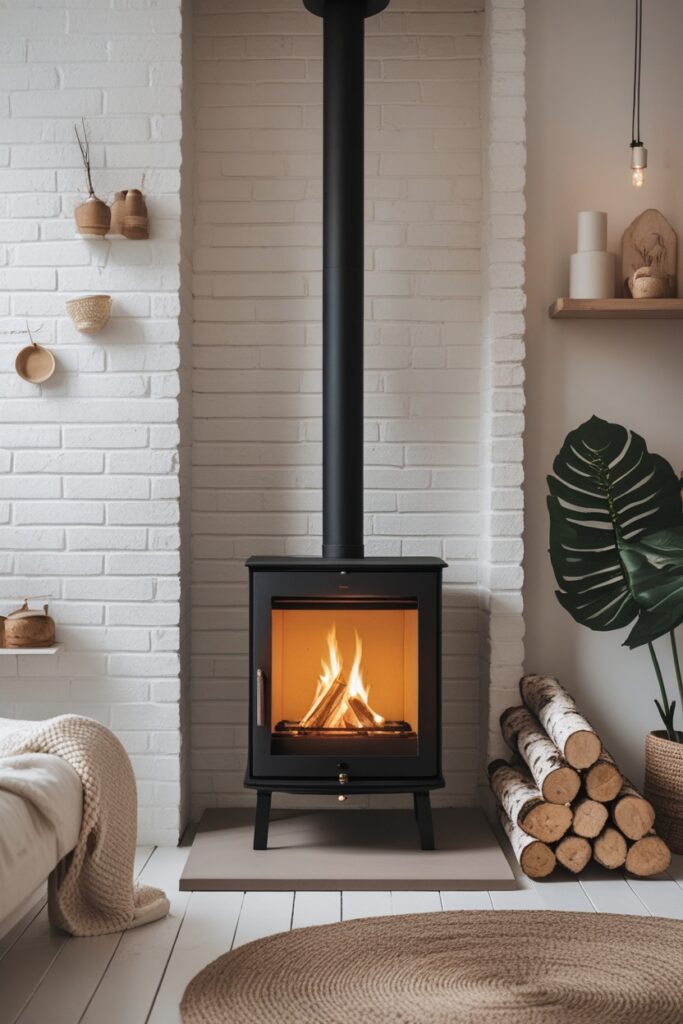
Scandi interiors still have a tight grip on design lovers. There’s something so grounding about pale woods, whitewashed walls, and just enough furniture to avoid echoing. Place a slim, upright stove against a white brick wall and the whole scene hums softly like a winter morning.
The fire’s orange glow looks sharper against all the whites and beiges. It becomes a natural artwork. A stack of birch logs by the side almost disappears into the colour palette but adds quiet rhythm.
If you’re chasing this vibe, don’t over decorate. One woven rug, a few floating shelves, a big leafy plant in the corner if you dare. Let the stove speak in its whispery way. It doesn’t need to shout to get attention.
6. Double-Sided Stove for Two Zones
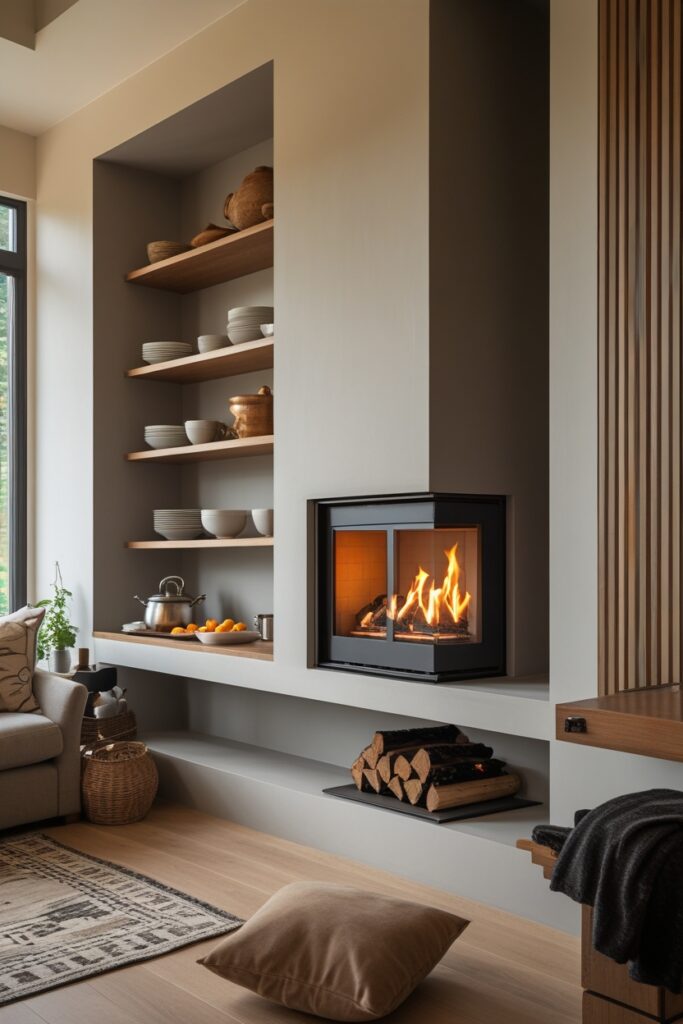
This one’s for the planners. A double-sided wood-burning stove built into a partition wall is clever beyond words. It warms two spaces at once say, a living room on one side and a dining area on the other. But more than that, it creates a subtle dialogue between the rooms.
You can sit on the sofa and see flames flicker through to the other side, where someone’s setting plates or sipping tea. It’s quietly connective. In open-plan homes, it creates zones without needing chunky walls or awkward furniture barricades.
For 2025 interiors, this approach nails the balance between coziness and flow. It’s warm, literally and figuratively, but doesn’t box anyone in. Plus, when both sides are active, it feels like a theatrical set, with the fire playing the lead role.
7. Earthy Bohemian Layering Around the Stove
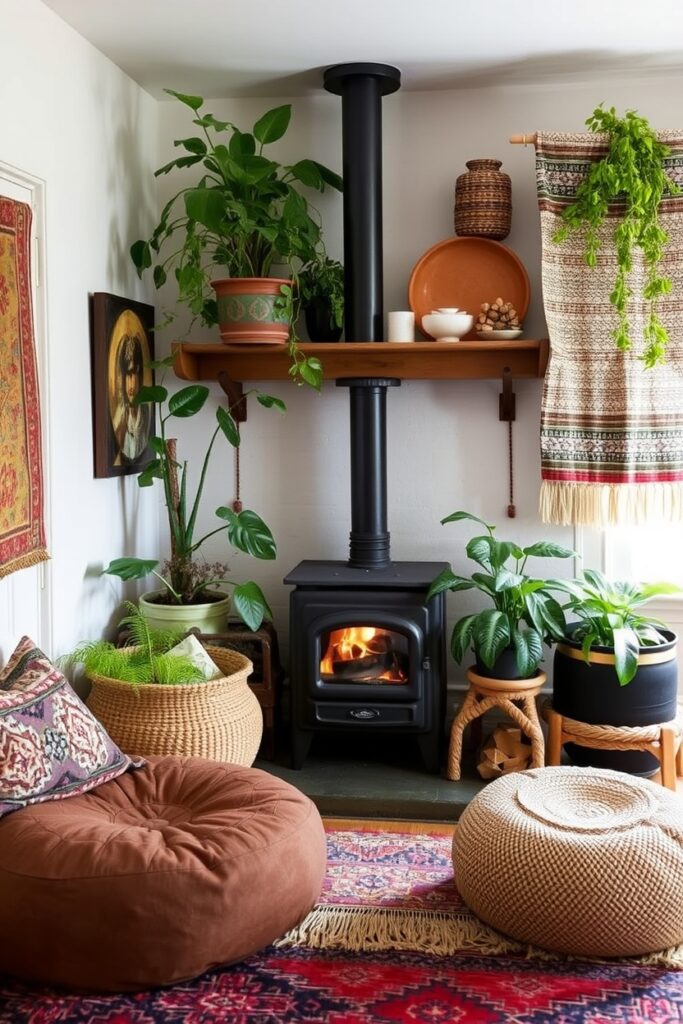
Boho interiors have evolved from cluttered corners with beads and feathers to something more refined but still wildly expressive. Here, a wood-burning stove becomes a sort of altar. Everything gathers around it plants, woven poufs, patterned rugs layered three deep.
It’s not polished. It’s alive. One fern leans too far into the warmth, a tapestry hangs slightly crooked, and that’s the charm. The stove doesn’t sit stiff in the corner; it’s surrounded by life.
Use clay pots, jute textures, and uneven wooden shelves. Let logs spill casually from their basket, not lined up like soldiers. When the flames are on, the whole scene looks like a warm hug dressed in eclectic clothes.
8. Minimalist Floating Stove on a Wall Panel
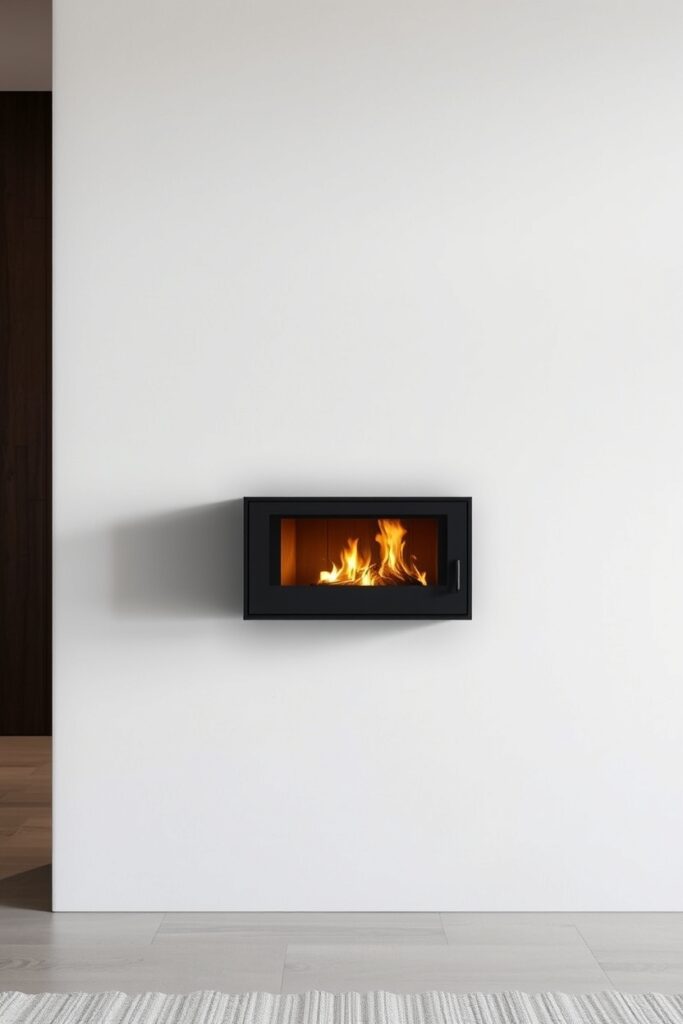
Minimalism doesn’t have to be cold. In fact, in 2025, the most interesting minimalist spaces are those that have a single, carefully chosen warm element. Here, a floating wood-burning stove mounted onto a smooth wall panel acts like that unexpected punctuation mark in a calm sentence.
The wall panel can be made of stone, matte steel, or dark wood, depending on the mood you want. The stove itself is slim, almost disappearing when not in use. But when the fire kicks in, it’s impossible to ignore.
This idea works wonders in smaller living rooms. No bulky hearths, no unnecessary bits. Just a sleek form with dancing flames in the middle, creating quiet drama without shouting for it.
9. Cottage core Nook with a Vintage Stove
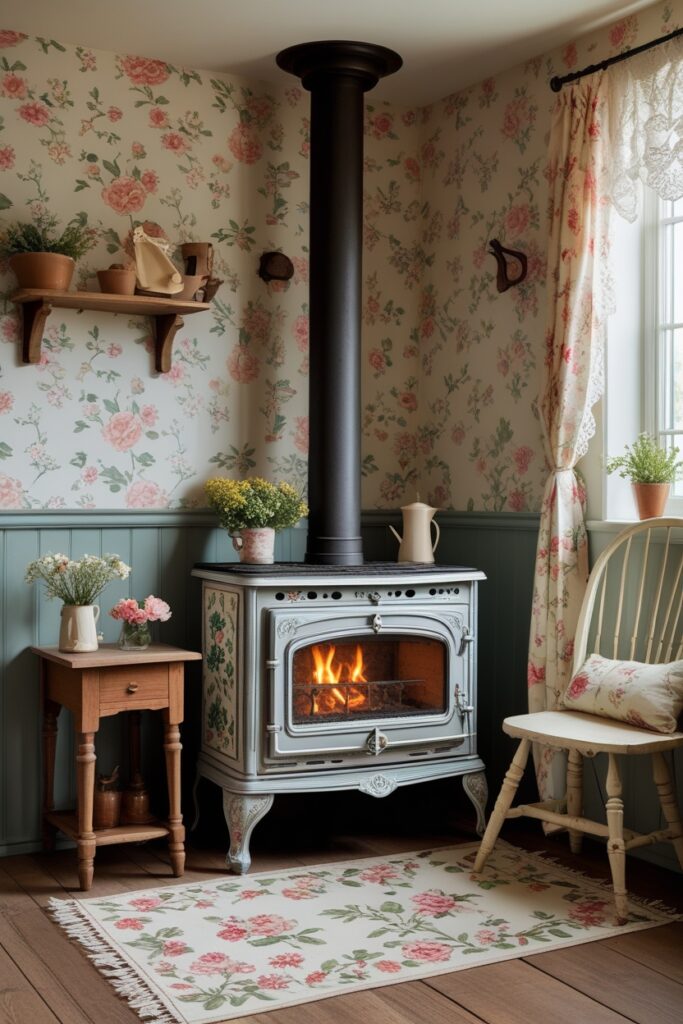
Cottage core is still floating around in 2025, but it’s grown a little wiser. Less fairy tale, more lived-in countryside charm. If you can get your hands on a vintage stove something a bit ornate, maybe with tiny feet and flowery patterns it can transform a nook like nothing else.
Imagine a little corner with floral wallpaper, a spindle chair, an old wooden table, and the stove sitting like a proud grandparent. Add lace curtains if you dare, but keep them subtle. The goal isn’t to play dress-up; it’s to make the space feel like it’s been loved for decades.
The smell of wood smoke mixing with floral notes is quietly intoxicating. It’s not trendy; it’s timeless, and that’s its power.
10. Statement Chimney Tower in the Middle of the Room
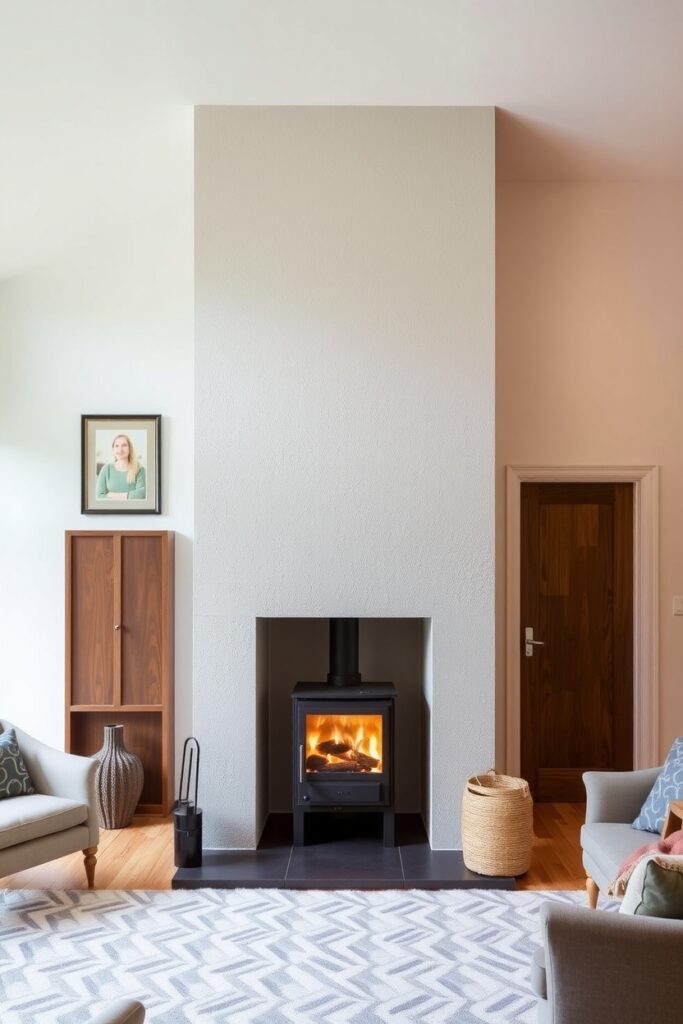
Last idea, and maybe the boldest. Instead of tucking your stove to one side, pull it right into the middle of the living room. Build a tall chimney tower, maybe with textured plaster or smooth white render, and let the stove sit at its base like a glowing heart.
This works especially well in big square rooms. The tower becomes a sculptural column. Furniture radiates around it like planets around a star. Conversations naturally gather near the warmth.
In 2025, this kind of unapologetic central design is gaining traction. People are tired of cornering their best features. The fire deserves better. Let it claim the centre, unapologetically.
11. Glass-Corner Stove Framing the View
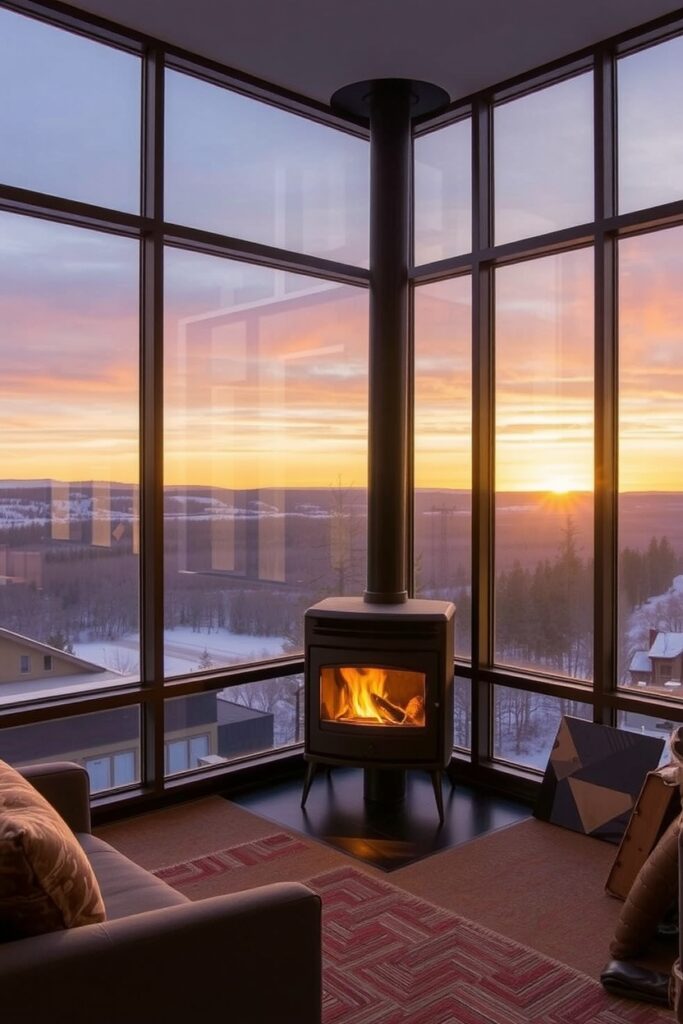
If your living room has floor-to-ceiling corner windows, don’t just stick the stove against some boring wall. Tuck it into that glass corner. Yes, really. The flames flicker while your outside view unfolds behind it it’s like a layered painting, alive and shifting.
The glass reflects the fire at night, doubling the drama without extra work. During the day, the black stove sits quietly, not blocking the scenery but adding weight to it. It’s bold but not loud, like someone wearing a sharp black coat in a snowstorm.
For a final touch, run a low bench along the windows. People end up sitting there, toes warming, eyes drifting outside. It’s addictive.
12. Curved Alcove Cocoon
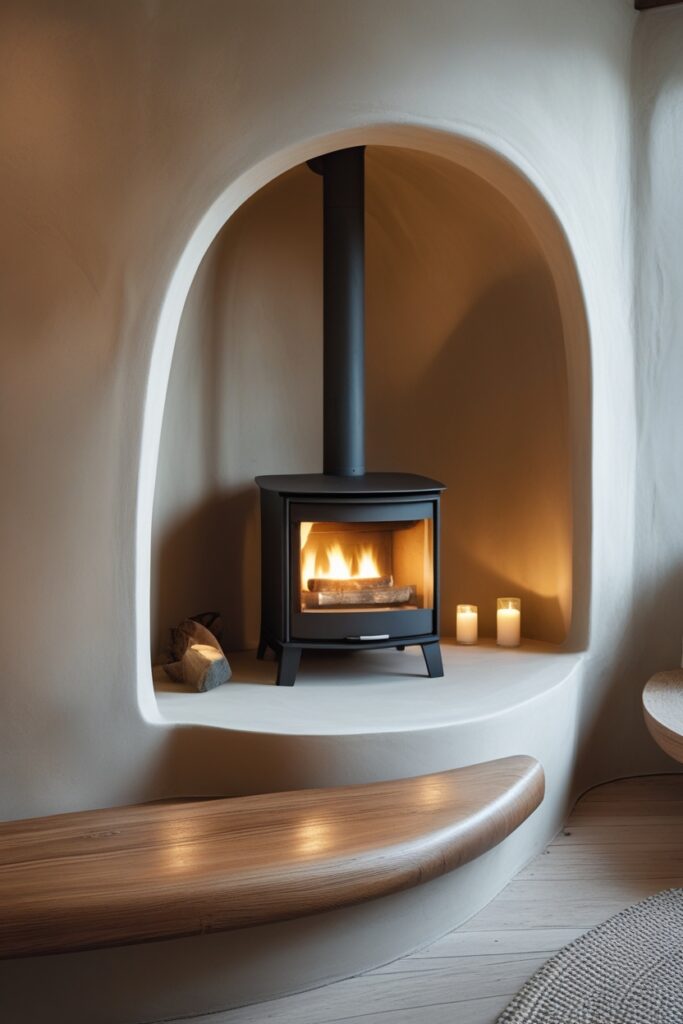
Straight lines are everywhere; that’s why curves feel so comforting. Build a rounded alcove for your stove, almost like a little cave, lined with smooth plaster or soft clay. The stove sits inside like a pearl in a shell.
This idea works ridiculously well in older cottages and ultra-modern homes alike. It softens everything, makes the corner feel hugged. When the fire glows inside that curved niche, the light spreads like honey, warm and thick.
Add a low curved bench around the alcove, and suddenly it becomes the most fought-over spot in the house.
13. Built-In Log Wall as a Design Feature
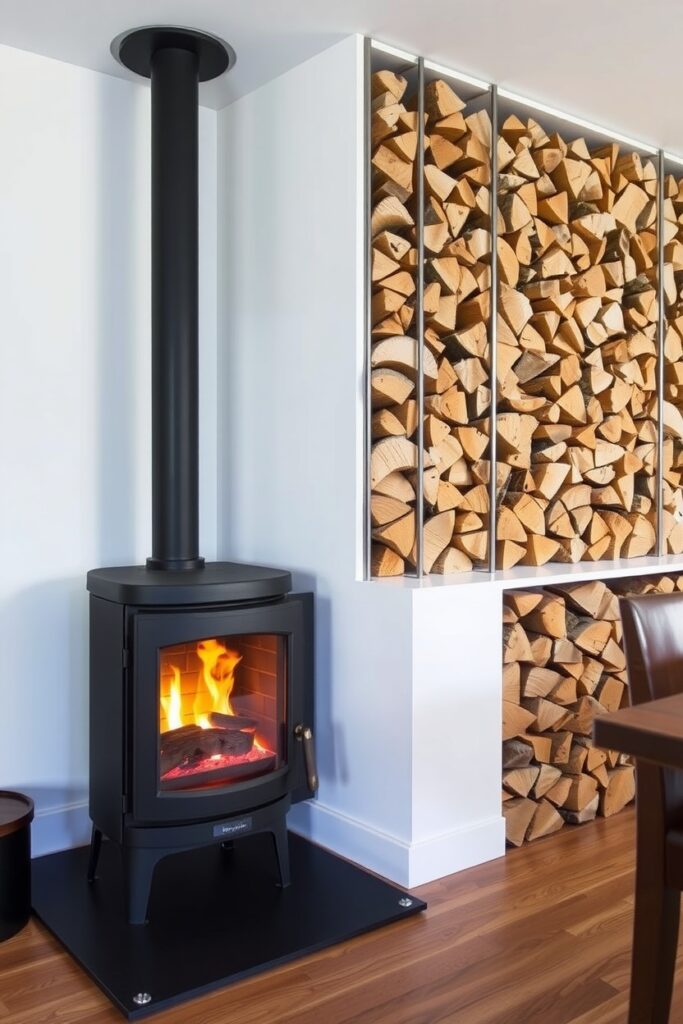
Forget stacking logs in a basket like it’s 1998. Dedicate an entire wall to neatly stacked firewood, almost like a rustic library. Vertical steel dividers keep the stacks tidy. The stove sits right beside, looking smug because it knows it’s part of the masterpiece.
The texture of chopped wood against a clean wall creates this odd but wonderful contrast. It’s warm, graphic, tactile, and kind of hypnotic.
Bonus: you’ll never run out of logs mid-evening. They’re literally staring at you, waiting their turn.
14. Japanese Wabi-Sabi Simplicity
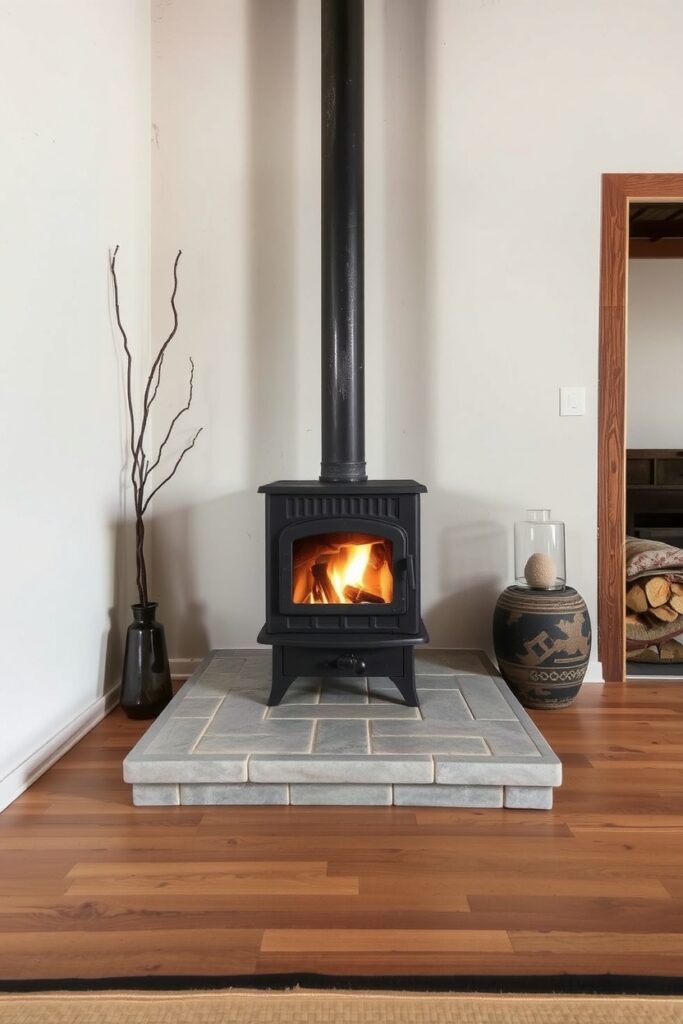
Wabi-sabi is all about imperfect beauty, quiet spaces, and things that feel like they’ve earned their place. A small, simple wood-burning stove on a smooth stone platform fits this philosophy like a glove.
Use rough plaster walls, a single low table, maybe a floor cushion or two. Nothing fancy. The fire does the talking. Its soft crackles feel meditative, like someone breathing slowly in the corner.
This isn’t about impressing guests. It’s about slowing the pace of the room. Letting things just be. In 2025, when everything’s rushing, this calm corner feels like a rebellion.
15. Loft Gallery with Exposed Flue
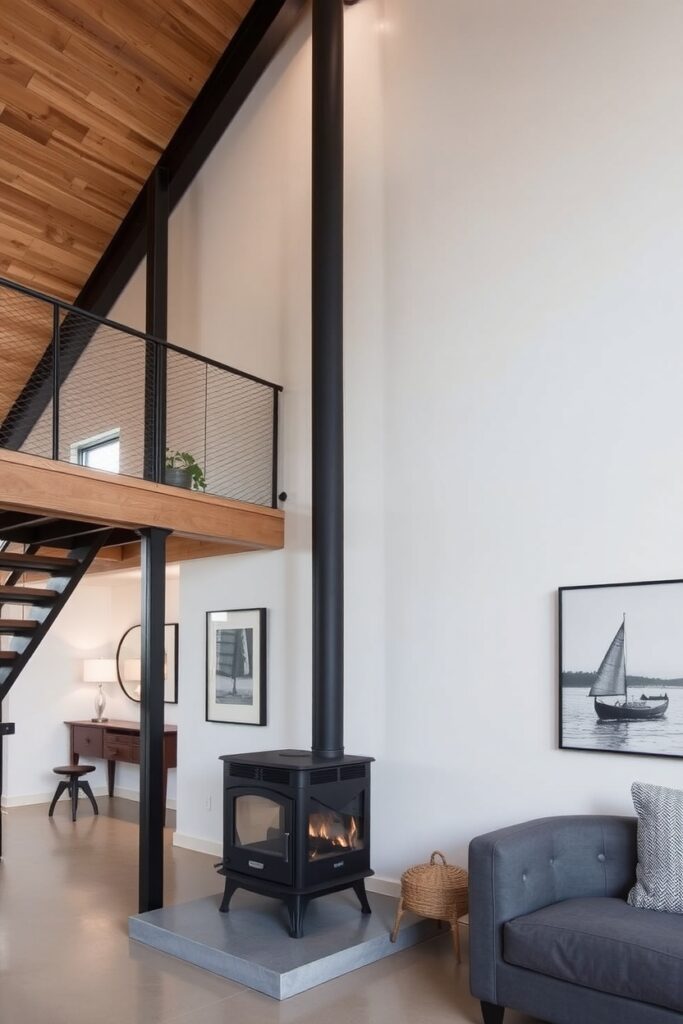
Instead of hiding the flue pipe, flaunt it. Let it rise dramatically through a tall loft space like a modern totem. Paint it matte black or soft charcoal, and suddenly it looks intentional almost architectural.
The stove sits on a low platform, maybe concrete, maybe polished stone. The flue stretches upward, cutting through space with a clean vertical line. You can even install subtle uplighting to highlight its height at night.
It gives the room this lofty, gallery-like vibe. Guests look up without even realising they’re doing it.
16. Garden-Linked Stove Nook
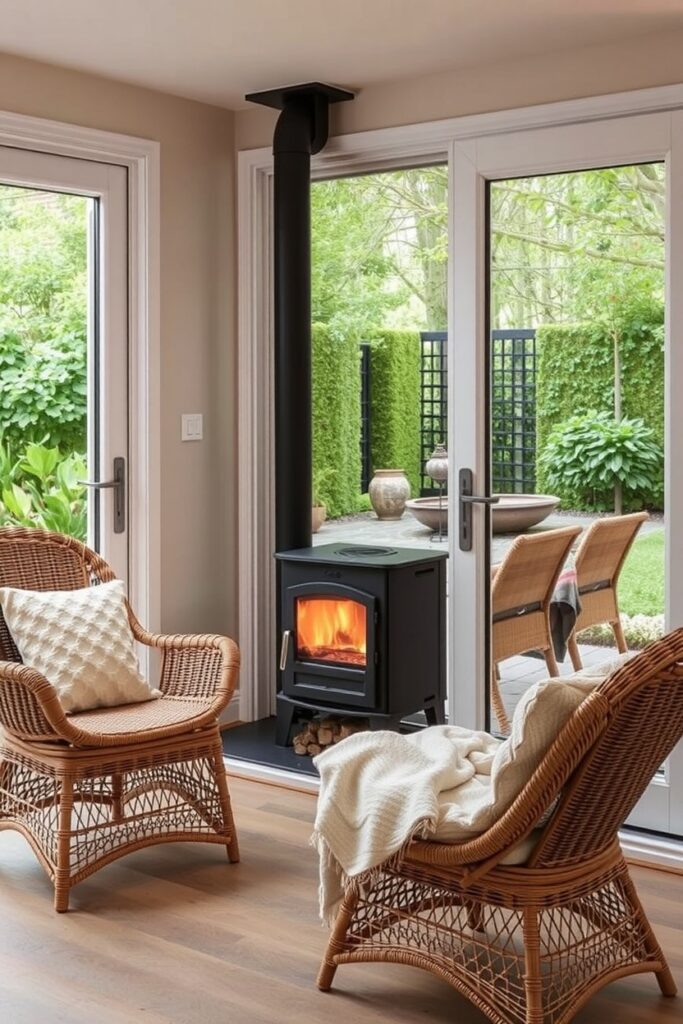
Slide your stove close to glass doors that lead straight into the garden or patio. The warmth of the fire spills out visually through the doors, pulling the outside in. It makes winter evenings feel less cut off from the world beyond the glass.
When you crack the door slightly, that mix of cold fresh air and wood smoke is quietly addictive. A couple of wicker chairs angled toward the glass, a soft blanket thrown over one arm, and you’ve basically made a countryside retreat… even if you’re in the suburbs.
This layout works best if your doors open onto greenery. Fire inside, nature outside. It’s a simple but powerful pairing.
17. Color Pop Stove as a Focal Point
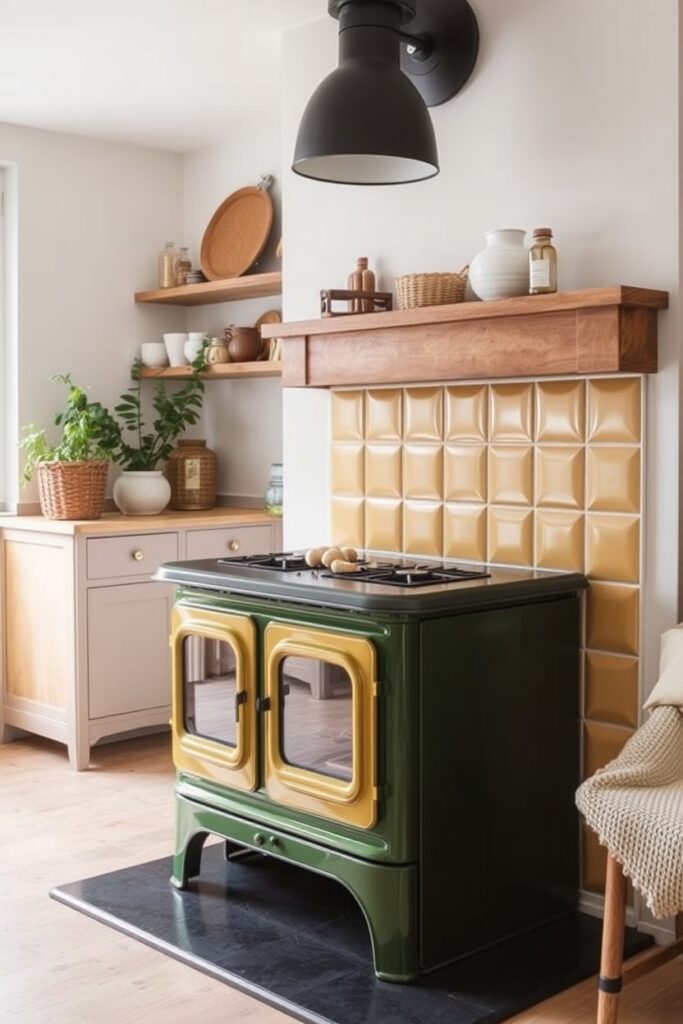
Not every stove needs to be black. In fact, in 2025, we’re seeing more coloured enamel stoves deep green, burnt orange, creamy white, even mustard yellow. Against neutral walls, they pop. Like jewellery for your living room.
Pick a bold colour and keep the surroundings calm. The stove becomes an instant conversation starter, but it’s also practical warmth. Green against white plaster gives English cottage vibes. Mustard against pale wood looks playful and modern.
It’s a small tweak, but it shifts the entire personality of the space.
18. Stairwell Integration
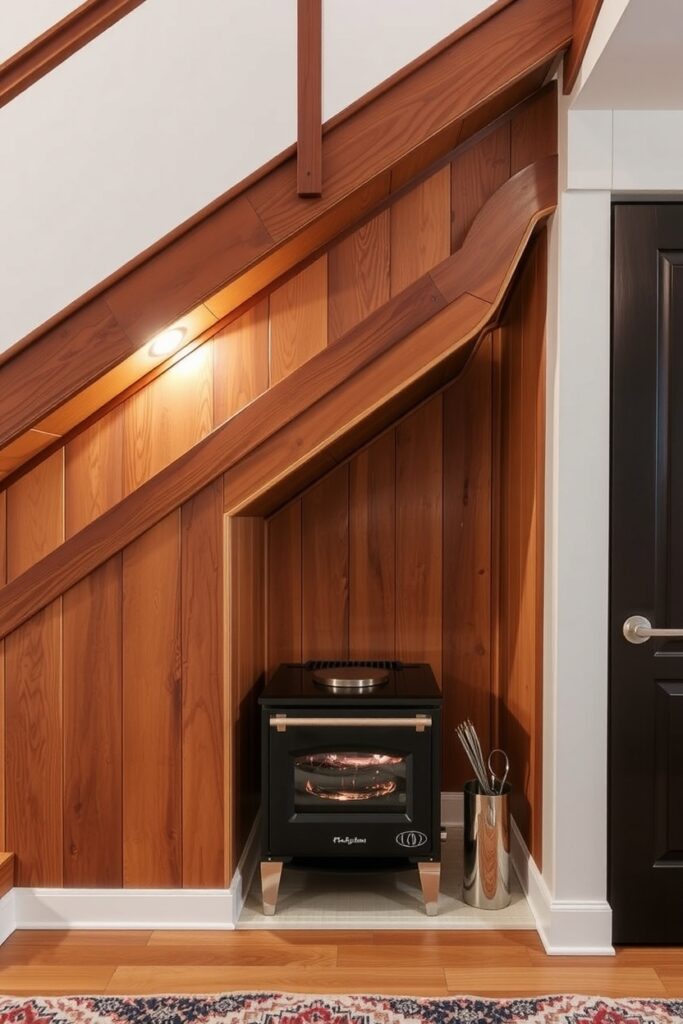
Got a staircase slicing through your living room? Use the under-stair space for the stove. It’s clever, space-saving, and honestly, it looks like it was meant to be there all along.
Line the underside of the stairs with heat-resistant panels. Add soft lighting tucked up into the treads so the whole nook glows gently at night. It turns a previously ignored pocket into a warm architectural moment.
This works especially well in split-level homes or townhouses where every inch counts.
19. Retro Revival with Tiled Surrounds
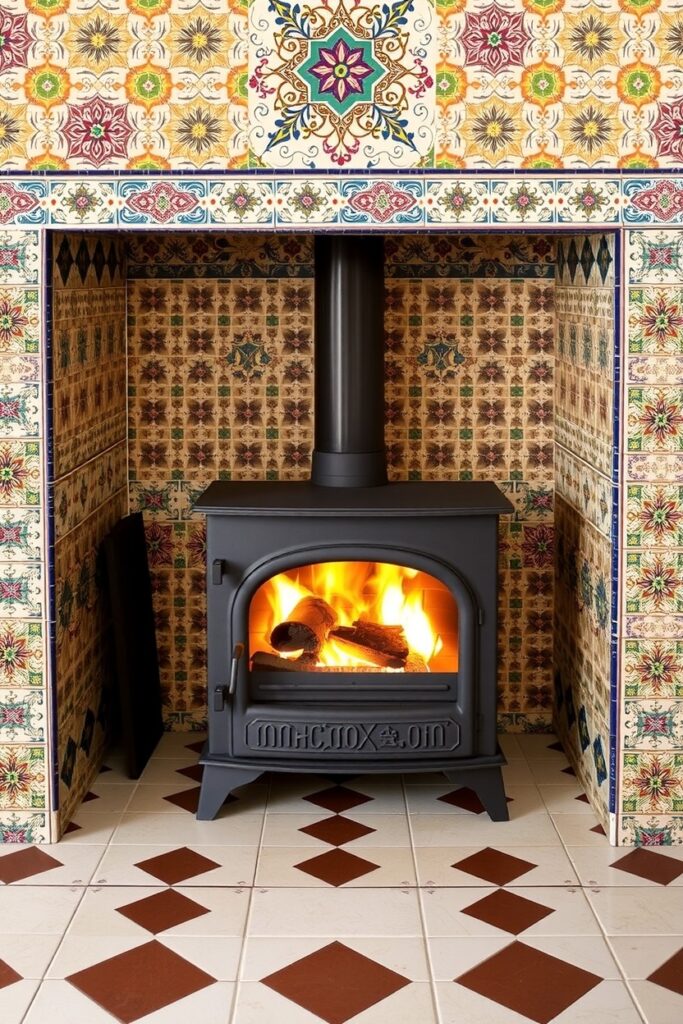
Vintage tilework is making a quiet comeback. Think Moroccan zellige, Victorian floral patterns, or even playful 1970s geometrics. Wrap your stove’s base or wall with these tiles, and suddenly it’s got a personality bigger than itself.
The stove doesn’t need to be vintage itself modern stoves look surprisingly striking against ornate tilework. It’s like pairing sneakers with a vintage dress: unexpected, stylish, a little cheeky.
Tiles also reflect light from the fire, so the whole area glimmers in a way plain walls never could.
20. Layered Ceiling Heights Around the Stove
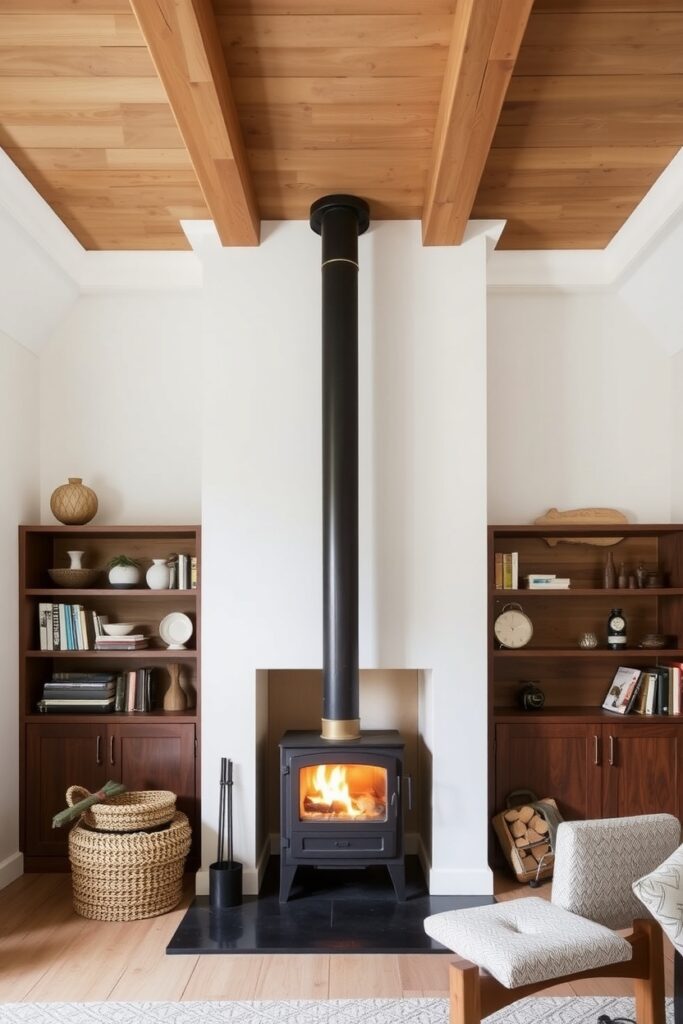
This is a designer’s trick that most homeowners never consider. Drop the ceiling subtly above the stove area maybe using timber slats or panels while keeping the rest of the room high. It frames the stove like a stage.
The lowered section traps warmth, makes the space feel snug, almost like a tucked-away corner without building walls. It’s brilliant for big, echoey rooms that need a bit of human scale brought back in.
When the fire’s on, the layered ceiling casts soft shadows that make everything look cinematic. Like you’ve walked into a scene rather than a room.
Final Thoughts
Wood-burning stoves aren’t fading into nostalgic memory; they’re evolving. They’re slipping into all kinds of interior languages modern, rustic, industrial, boho, minimalist like they were always meant to be there. And with energy costs rising and design tastes leaning toward tactile, meaningful spaces, their role feels more relevant than ever.
The beauty of these ideas isn’t just in how they look, but in how they feel. The sound of wood popping late at night. The way the light flickers across a rough wall. The smell that sticks softly to your jumper long after the fire’s gone out.
A living room with a wood-burning stove isn’t just designed; it’s experienced. And that’s something no glossy surface or LED strip can replicate.

